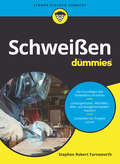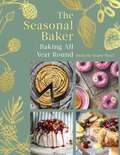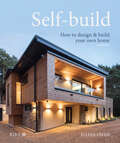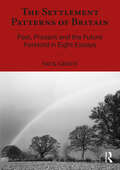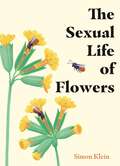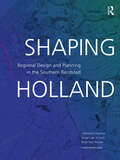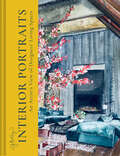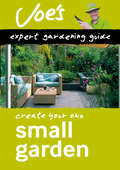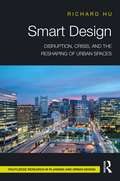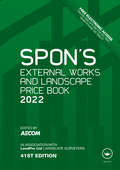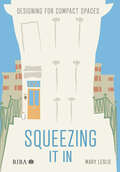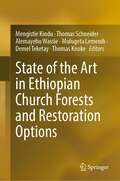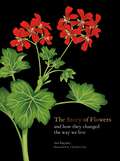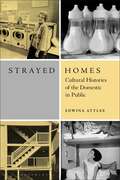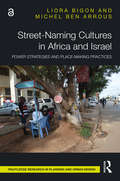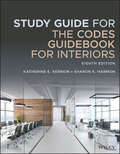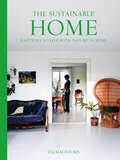- Table View
- List View
Schweißen für Dummies (Für Dummies)
by Steven Robert FarnsworthSie wollen Schweißen lernen? Sei es als Hobby, beruflich oder im Rahmen einer Ausbildung? Dann ist dieses Buch das richtige für Sie. Stephen Robert Farnsworth hilft Ihnen bei den ersten Schritten, das Schweißen zu erlernen. Er erklärt Ihnen, was Sie zu Lichtbogenhand-, MIG/MAG-, WIG- und Autogenschweißen wissen sollten. Sie erfahren, was Sie bei welchen Metallen beachten sollten und wann sich welches Schweißverfahren anbietet. Ein besonderes Augenmerk legt der Autor auf die Sicherheit, denn die geht schließlich immer vor. So sind Sie mit diesem Buch rundum gut beraten, wenn Sie Schweißen lernen wollen.
The Seasonal Baker: Baking All Year Round
by Michelle Evans-FecciSeasonal bakes and tips on growing your own produce by former The Great British Bake Off contestant, Michelle Evans-FecciFormer Bake Off contestant Michelle was known on the show for her flavoursome, colourful bakes and for championing seasonal, locally sourced and homegrown produce. Whether it's a simple loaf for breakfast or a striking showstopper cake for a celebration, she loves using seasonal food to create tasty recipes for the whole family to enjoy. The Seasonal Baker is a collection of recipes straight from Michelle's kitchen to yours - from quick-and-easy bakes to others that are a bit more challenging - with an emphasis on special events such as Easter, Halloween and Christmas. Inside you will find delicious, vibrant recipes such as: - Hot Cross Bun Bread and Butter Pudding- Truffle, Rosemary and Garlic Focaccia- Smokey Pulled Pork Sausage Rolls- Butternut Squash, Feta, Maple and Pecan Cups- Vanilla, Rhubarb and Raspberry Celebration CakeMichelle grew up on a farm and learned from a young age how to grow vegetables and the basics of cooking and baking. She now lives in the beautiful seaside town of Tenby in Pembrokeshire with her husband Ben, their teenage son Alfie, little whippet Rosie, and two cheeky hens. As a family they love to be out in the garden where they grow a lot of the fruit, vegetables and herbs that Michelle uses in her everyday cooking. The book shows just how easy and rewarding it is to grow your own produce.As well as delicious bakes for all abilities, The Seasonal Baker contains hints and tips on ways of being thrifty with food. There is something for everyone, from what to plant, when to plant it and when to harvest - whether you have access to a plant pot, window box, balcony, raised bed or garden veg patch with intuitive, creative photos to help.
Self-build: How to design and build your own home
by Julian OwenIf you’ve ever dreamt of designing and building your own home, this book is for you. Becoming a ‘self-builder’ doesn’t necessarily mean learning to build a house physically from scratch. Anyone can be a self-builder – you can do so without ever having to lay a brick yourself. Self-built homes can also be more individual, better designed and more economical than buying from a developer. This book is designed for homeowners and self-builders, whether aspiring or on the brink of starting a project. It provides a jargon-free, step-by-step guide to the process of designing and building your own home, distilling all of the practical information needed to make your dream house a reality. Carefully crafted to offer friendly, easy-to-understand practical guidance and packed with watch points, hints and tips, it also highlights the potential pitfalls and suggests ways of avoiding them. Including indications of costs and timescales, Self-build demystifies the process of budgeting, finding a site, gaining planning permission, designing your home and all of the surrounding issues to do with sustainability, planning, regulations, procurement and the use of building contracts. Beautifully illustrated with over 230-colour photos, diagrams and plans, it provides all the inspiration and ideas you need to bring your own project to life. Featured houses include: Amphibious House by Baca Architects Corten Courtyard House by Barefoot Architects Haringey Brick House by Satish Jassal Architects Shawm House by Mawson Kerr Architects Sussex House by Wilkinson King Architects The Pocket House by Tikari Works Architects.
Self-build: How to design and build your own home
by Julian OwenIf you’ve ever dreamt of designing and building your own home, this book is for you. Becoming a ‘self-builder’ doesn’t necessarily mean learning to build a house physically from scratch. Anyone can be a self-builder – you can do so without ever having to lay a brick yourself. Self-built homes can also be more individual, better designed and more economical than buying from a developer. This book is designed for homeowners and self-builders, whether aspiring or on the brink of starting a project. It provides a jargon-free, step-by-step guide to the process of designing and building your own home, distilling all of the practical information needed to make your dream house a reality. Carefully crafted to offer friendly, easy-to-understand practical guidance and packed with watch points, hints and tips, it also highlights the potential pitfalls and suggests ways of avoiding them. Including indications of costs and timescales, Self-build demystifies the process of budgeting, finding a site, gaining planning permission, designing your home and all of the surrounding issues to do with sustainability, planning, regulations, procurement and the use of building contracts. Beautifully illustrated with over 230-colour photos, diagrams and plans, it provides all the inspiration and ideas you need to bring your own project to life. Featured houses include: Amphibious House by Baca Architects Corten Courtyard House by Barefoot Architects Haringey Brick House by Satish Jassal Architects Shawm House by Mawson Kerr Architects Sussex House by Wilkinson King Architects The Pocket House by Tikari Works Architects.
The Settlement Patterns of Britain: Past, Present and the Future Foretold in Eight Essays (Planning, History and Environment Series)
by Nick GreenIn writing The Settlement Patterns of Britain Nick Green was inspired by the short story genre. His book is a collection of eight non-fiction short stories or essays, where the characters are the places, some of which appear more than once, usually as bit-part players, occasionally as the main protagonist. Preceded by a prologue describing Britain’s prehistory as a European peninsula, each essay covers a fixed period in the history of the development of Britain’s settlement patterns, sometimes long, more often quite short, beginning around 2,500 BC and ending about one hundred years in the future. Nick Green chose those periods that are particularly instructive in revealing how settlement patterns come to exist in the form they do and how they might develop in the future. Settlement patterns are not just about where a place is, but about how that place relates to others. They wax and wane with circumstance, and around each settlement’s fixed core, the patterns of living and working shift constantly, driven by forces beyond the control of any individual town or city or village. From Bronze Age communities to computer simulations, from the mediaeval wool trade to the hyper-networked society, from Viking invasions to the post-industrial era, the essays cover a broad sweep of history. They appear in chronological order, but are not intended to provide a continuous, linear historical narrative – nor do they: each essay is freestanding so they can be read in whatever order the reader prefers.
The Settlement Patterns of Britain: Past, Present and the Future Foretold in Eight Essays (Planning, History and Environment Series)
by Nick GreenIn writing The Settlement Patterns of Britain Nick Green was inspired by the short story genre. His book is a collection of eight non-fiction short stories or essays, where the characters are the places, some of which appear more than once, usually as bit-part players, occasionally as the main protagonist. Preceded by a prologue describing Britain’s prehistory as a European peninsula, each essay covers a fixed period in the history of the development of Britain’s settlement patterns, sometimes long, more often quite short, beginning around 2,500 BC and ending about one hundred years in the future. Nick Green chose those periods that are particularly instructive in revealing how settlement patterns come to exist in the form they do and how they might develop in the future. Settlement patterns are not just about where a place is, but about how that place relates to others. They wax and wane with circumstance, and around each settlement’s fixed core, the patterns of living and working shift constantly, driven by forces beyond the control of any individual town or city or village. From Bronze Age communities to computer simulations, from the mediaeval wool trade to the hyper-networked society, from Viking invasions to the post-industrial era, the essays cover a broad sweep of history. They appear in chronological order, but are not intended to provide a continuous, linear historical narrative – nor do they: each essay is freestanding so they can be read in whatever order the reader prefers.
The Sexual Life of Flowers
by Simon Klein'A fascinating treasure trove for plant lovers and gardeners alike.' - Frances TophillOften beautiful and sometimes strange, flowering plants have evolved to become masters of seduction.We are surrounded by extraordinary partnerships between plants and the birds, bees and other insects that pollinate them. In The Sexual Life of Flowers, botanist Simon Klein leads a beguiling and fascinating tour of the courtship between fifty flowers and the pollinators vital to their survival.From the siren scent of honeysuckle to the radiating warmth of the sunflower or the ultraviolet signal of the red poppy; tales of botanical charm, deception and intrigue are played out amid an annual explosion of activity in gardens, meadows and woodlands. Lavishly illustrated in full colour, this is a beautiful collection for gardeners and anyone with an interest in flowers.
Shaping Holland: Regional Design and Planning in the Southern Randstad
by Jeroen van Schaick Francisco Colombo Peter WitsenAll around the world, regions are facing major challenges: climate change, the transition to renewable energy, reinventing the food system, ongoing urbanisation and finding room to sustain biodiversity. These will radically transform our living and working environments. Regional design uses the power of visualisation to unite regional players around appealing spatial development visions for meeting those challenges. It offers a route to new forms of regional governance and planning that match the urgencies of our time. This book exposes the benefits and the pitfalls of regional plans and designs. Shaping Holland gives a unique insight into the emergence of contemporary regional planning and design practice in the Netherlands. This densely populated country in the delta of the Rhine and Meuse rivers is internationally renowned for its urban planning and design tradition. Drawing on first-hand accounts and a rich collection of illustrations, maps and diagrams, the book gives pointers for practitioners, academics and students of spatial planning, urban design and landscape architecture. Regional design is on the rise in all continents. It provides an answer to a world in which economic activities, activity patterns, urban growth and ecological systems are no respecters of administrative boundaries. Amid the growing number of academic analyses of regional design, this book is unique because it focuses on planning practice and first-hand knowledge. As such it is of interest to a broad international readership.
Shaping Holland: Regional Design and Planning in the Southern Randstad
by Jeroen van Schaick Francisco Colombo Peter WitsenAll around the world, regions are facing major challenges: climate change, the transition to renewable energy, reinventing the food system, ongoing urbanisation and finding room to sustain biodiversity. These will radically transform our living and working environments. Regional design uses the power of visualisation to unite regional players around appealing spatial development visions for meeting those challenges. It offers a route to new forms of regional governance and planning that match the urgencies of our time. This book exposes the benefits and the pitfalls of regional plans and designs. Shaping Holland gives a unique insight into the emergence of contemporary regional planning and design practice in the Netherlands. This densely populated country in the delta of the Rhine and Meuse rivers is internationally renowned for its urban planning and design tradition. Drawing on first-hand accounts and a rich collection of illustrations, maps and diagrams, the book gives pointers for practitioners, academics and students of spatial planning, urban design and landscape architecture. Regional design is on the rise in all continents. It provides an answer to a world in which economic activities, activity patterns, urban growth and ecological systems are no respecters of administrative boundaries. Amid the growing number of academic analyses of regional design, this book is unique because it focuses on planning practice and first-hand knowledge. As such it is of interest to a broad international readership.
SJ Axelby’s Interior Portraits: An Artist's View Of Designers' Living Spaces
by SJ AxelbyAn artist’s record of the homes of 89 leading creatives from interior designers to ceramicists, antiques dealers, florists and chefs.
Small Garden: Create Your Own Green Space With This Expert Gardening Guide (Collins Gardening)
by Joe Swift Collins BooksCreate your own small garden with expert gardener Joe Swift. Green spaces are the perfect antidote to fast city living. Learn how to create your own small garden with expert gardener Joe Swift’s practical, easy-to-follow advice. From courtyards to rooftops, transform awkward and unexciting spaces with inspirational ideas and solutions.
Smart Design: Disruption, Crisis, and the Reshaping of Urban Spaces
by Richard HuThis book tackles the emerging smart urbanism to advance a new way of urban thinking and to explore a new design approach. It unravels several urban transformations in dualities: economic relationality and centrality, technological flattening and polarisation, and spatial division and fusion. These dualities are interdependent; concurrent, coexisting, and contradictory, they are jointly disrupting and reshaping many aspects of contemporary cities and spaces. The book draws on a suite of international studies, experiences, and observations, including case studies in Beijing, Singapore, and Boston, to reveal how these processes are impacting urban design, development, and policy approaches. The COVID-19 pandemic has accelerated many changes already in motion, and provides an extreme circumstance for reflecting on and imagining urban spaces. These analyses, thoughts, and visions inform an urban imaginary of smart design that incorporates change, flexibility, collaboration, and experimentation, which together forge a paradigm of urban thinking. This paradigm builds upon the modernist and postmodernist urban design traditions and extends them in new directions, responding to and anticipating a changing urban environment. The book proposes a smart design manifesto to stimulate thought, trigger debate, and, hopefully, influence a new generation of urban thinkers and smart designers. It will be of interest to scholars, students, and practitioners in the fields of urban design, planning, architecture, urban development, and urban studies.
Smart Design: Disruption, Crisis, and the Reshaping of Urban Spaces
by Richard HuThis book tackles the emerging smart urbanism to advance a new way of urban thinking and to explore a new design approach. It unravels several urban transformations in dualities: economic relationality and centrality, technological flattening and polarisation, and spatial division and fusion. These dualities are interdependent; concurrent, coexisting, and contradictory, they are jointly disrupting and reshaping many aspects of contemporary cities and spaces. The book draws on a suite of international studies, experiences, and observations, including case studies in Beijing, Singapore, and Boston, to reveal how these processes are impacting urban design, development, and policy approaches. The COVID-19 pandemic has accelerated many changes already in motion, and provides an extreme circumstance for reflecting on and imagining urban spaces. These analyses, thoughts, and visions inform an urban imaginary of smart design that incorporates change, flexibility, collaboration, and experimentation, which together forge a paradigm of urban thinking. This paradigm builds upon the modernist and postmodernist urban design traditions and extends them in new directions, responding to and anticipating a changing urban environment. The book proposes a smart design manifesto to stimulate thought, trigger debate, and, hopefully, influence a new generation of urban thinkers and smart designers. It will be of interest to scholars, students, and practitioners in the fields of urban design, planning, architecture, urban development, and urban studies.
Spon's External Works and Landscape Price Book 2022 (Spon's Price Books)
by Aecom AecomNow in its 41st edition, Spon's External Works and Landscape Price Book 2022 offers the only comprehensive source of information for detailed external works and landscape costs. It covers all the items to be found in hard and soft landscape contracts, and forms an indispensable reference book for quantity surveyors, landscape architects, contractors and local authority managers – essential for compiling estimates, specifications, bills of quantities and works schedules – no matter what the size of the project being undertaken. The 2022 edition includes new stainless-steel products including: ventilation grilles; handrails; LED handrails; in ground power units; stainless steel bollards; stainless steel warning strips and studs and access covers. Also, an extended range of inspection chambers, new podium specialist soils and a new formwork system, as well as two new Cost Models, one for podiums and another for landscape maintenance. All the standard features that you expect from SPON'S EXTERNAL WORKS AND LANDSCAPE PRICE BOOK remain: • material and measured work prices covering contract items from preliminaries and site clearance and encompassing the core external works activities with full breakdowns into labour, materials and other components • detailed guidance on wage rates, landscape consultants’ fee scales • an extensive Approximate Estimates section for rapid spot estimating • updates, free of charge, twice a year – see inside for registration details. Updates are available online at www.pricebooks.co.uk Use the access code inside the front cover of the book to get set up with an ebook of this 2022 edition on the VitalSource® Bookshelf platform, available for access and use until the end of December 2022.
Spon's External Works and Landscape Price Book 2022 (Spon's Price Books)
by AecomNow in its 41st edition, Spon's External Works and Landscape Price Book 2022 offers the only comprehensive source of information for detailed external works and landscape costs. It covers all the items to be found in hard and soft landscape contracts, and forms an indispensable reference book for quantity surveyors, landscape architects, contractors and local authority managers – essential for compiling estimates, specifications, bills of quantities and works schedules – no matter what the size of the project being undertaken. The 2022 edition includes new stainless-steel products including: ventilation grilles; handrails; LED handrails; in ground power units; stainless steel bollards; stainless steel warning strips and studs and access covers. Also, an extended range of inspection chambers, new podium specialist soils and a new formwork system, as well as two new Cost Models, one for podiums and another for landscape maintenance. All the standard features that you expect from SPON'S EXTERNAL WORKS AND LANDSCAPE PRICE BOOK remain: • material and measured work prices covering contract items from preliminaries and site clearance and encompassing the core external works activities with full breakdowns into labour, materials and other components • detailed guidance on wage rates, landscape consultants’ fee scales • an extensive Approximate Estimates section for rapid spot estimating • updates, free of charge, twice a year – see inside for registration details. Updates are available online at www.pricebooks.co.uk Use the access code inside the front cover of the book to get set up with an ebook of this 2022 edition on the VitalSource® Bookshelf platform, available for access and use until the end of December 2022.
Squeezing It In: Designing for compact spaces
by Mary LeslieOur living spaces are getting smaller but, as we spend more time at home, they must now work harder than ever to provide us with room to relax, work and entertain. Interior designers need to understand how to build accessibility, circulation, storage and lighting into the most restricted areas, without compromising on style. In this jargon-free guide, Mary Leslie demonstrates how to design for compact living, proposing creative solutions that can be applied to a variety of settings. A versatile designer may be addressing a cramped studio flat one day and a dressing room for an international business traveller the next; this book provides inspiration and advice for every kind of small space, and every budget. Organised around the different areas of the home, Squeezing It In examines familiar problems and offers clever, immediately applicable ideas for making the best of pocket-sized spaces. The entire design process is considered alongside complete examples, from the UK and internationally, which are generously illustrated with full-colour photographs, plans and sketches. Featuring case studies from: Archio Ltd Armstrong Keyworth Benjamin Tindall Architects Darren Oldfield Architects Jeffreys Interiors Papa Architects Peden & Pringle Plankbridge Ltd.
Squeezing It In: Designing for compact spaces
by Mary LeslieOur living spaces are getting smaller but, as we spend more time at home, they must now work harder than ever to provide us with room to relax, work and entertain. Interior designers need to understand how to build accessibility, circulation, storage and lighting into the most restricted areas, without compromising on style. In this jargon-free guide, Mary Leslie demonstrates how to design for compact living, proposing creative solutions that can be applied to a variety of settings. A versatile designer may be addressing a cramped studio flat one day and a dressing room for an international business traveller the next; this book provides inspiration and advice for every kind of small space, and every budget. Organised around the different areas of the home, Squeezing It In examines familiar problems and offers clever, immediately applicable ideas for making the best of pocket-sized spaces. The entire design process is considered alongside complete examples, from the UK and internationally, which are generously illustrated with full-colour photographs, plans and sketches. Featuring case studies from: Archio Ltd Armstrong Keyworth Benjamin Tindall Architects Darren Oldfield Architects Jeffreys Interiors Papa Architects Peden & Pringle Plankbridge Ltd.
State of the Art in Ethiopian Church Forests and Restoration Options
by Thomas Schneider Demel Teketay Mengistie Kindu Alemayehu Wassie Mulugeta Lemenih Thomas KnokeThis book, with contributions from leading academics - and including reviews and case studies from Ethiopian Church forests - provides a valuable reference for advanced students and researchers interested in forest and other natural resource management, ecology and ecosystem services as well as restoration options. The book addresses various aspects including a general overview of Ethiopian church forests, the present role and future challenges of church forests. It also discusses their structure and diversity in the context of sustainability and discusses restoration options for surrounding landscapes, under consideration of the circumstances of the land and the needs of surrounding communities. The intended readership includes natural resource professionals in general as well as forestry professionals in particular (practitioners, policymakers, educators and researchers). The book will provide the reader with a good foundation for understanding Ethiopian forest resources and restoration options of degraded landscape.
The Story of Flowers: And How They Changed the Way We Live
by Noel KingsburyThroughout history flowers have been an integral part of human survival and culture – as food, for medicine, to express feelings, as symbols, to commemorate and celebrate, and to decorate. Their shapes, colours, scents and textures have always attracted us, as they do animals and insects. Flowers are used as luxury spices (saffron), and as colouring and flavouring agents – marigolds fed to chickens make eggs more yellow and lavender was Elizabeth I’s favourite flavour of jam. Flowers are full of symbolic meaning: violets represent modesty, daises purity and daffodils unrequited love. And they have always played an important role in culture through myths and legends, literature and the decorative arts. This delightful new book brings together 100 of the world’s flowers to tell their remarkable stories. Each flower is richly illustrated in colour and accompanied by facts about each species and what role it has played in our culture and history.
Strayed Homes: Cultural Histories of the Domestic in Public
by Edwina AttleeStrayed Homes explores the blurring of public and private space. But whereas most writing about the public/private focusses on urban space, Strayed Homes focusses on the domestic – exploring those overlooked, everyday places where private and intimate activities take place in public.With four chapters set in four small, liminal spaces: the launderette, the greasy spoon, the fire escape, and the sleeper train - the book is part architectural history, part cultural history. It follows a series of allusions and impressions, to explore how films, adverts, books and anecdotes shape experiences of everyday architecture. Making a case for the poetic interpretation of space, the book can be used as a sourcebook for architects and designers as well as for theorists. It invites the reader – by embracing the notion of the 'strayed home' – to think again about concepts that are commonly invoked in the fields of architecture and urbanism, such as 'private', 'public' and 'home', and to rethink the emotional state of leaving home, intimacy in public, and lonely dreaming.
Street-Naming Cultures in Africa and Israel: Power Strategies and Place-Making Practices
by Liora Bigon Michel Ben ArrousThis book is focused on the street-naming politics, policies and practices that have been shaping and reshaping the semantic, textual and visual environments of urban Africa and Israel. Its chapters expand on prominent issues, such as the importance of extra-formal processes, naming reception and unofficial toponymies, naming decolonisation, place attachment, place- making and the materiality of street signage. By this, the book directly contributes to the mainstreaming of Africa’s toponymic cultures in recent critical place-names studies. Unconventionally and experimentally, comparative glimpses are made throughout between toponymic experiences of African and Israeli cities, exploring pioneering issues in the overwhelmingly Eurocentric research tradition. The latter tends to be concentrated on Europe and North America, to focus on nationalistic ideologies and regime change and to over-rely on top-down ‘mere’ mapping and street indexing. This volume is also unique in incorporating a rich and stimulating variety of visual evidence from a wide range of African and Israeli cities. The materiality of street signage signifies the profound and powerful connections between structured politics, current mundane practices, historical traditions and subaltern cultures. Street-Naming Cultures in Africa and Israel is an important contribution to urban studies, toponymic research and African studies for scholars and students.
Street-Naming Cultures in Africa and Israel: Power Strategies and Place-Making Practices
by Liora Bigon Michel Ben ArrousThis book is focused on the street-naming politics, policies and practices that have been shaping and reshaping the semantic, textual and visual environments of urban Africa and Israel. Its chapters expand on prominent issues, such as the importance of extra-formal processes, naming reception and unofficial toponymies, naming decolonisation, place attachment, place- making and the materiality of street signage. By this, the book directly contributes to the mainstreaming of Africa’s toponymic cultures in recent critical place-names studies. Unconventionally and experimentally, comparative glimpses are made throughout between toponymic experiences of African and Israeli cities, exploring pioneering issues in the overwhelmingly Eurocentric research tradition. The latter tends to be concentrated on Europe and North America, to focus on nationalistic ideologies and regime change and to over-rely on top-down ‘mere’ mapping and street indexing. This volume is also unique in incorporating a rich and stimulating variety of visual evidence from a wide range of African and Israeli cities. The materiality of street signage signifies the profound and powerful connections between structured politics, current mundane practices, historical traditions and subaltern cultures. Street-Naming Cultures in Africa and Israel is an important contribution to urban studies, toponymic research and African studies for scholars and students.
Study Guide for The Codes Guidebook for Interiors
by Katherine E. Kennon Sharon K. HarmonSTUDY GUIDE FOR THE CODES GUIDEBOOK FOR INTERIORS The comprehensive study guide for understanding interior codes This revised and updated eighth edition of the Study Guide for the Codes Guidebook for Interiors is an essential companion to The Codes Guidebook for Interiors, the industry’s reference of choice. It offers complete coverage of the major codes and standards that apply to interior projects. This Study Guide includes lists of terms, practice questions, practical application exercises, code tables, and checklists. This companion study guide is a comprehensive measure of a designer’s understanding and application of codes for interior projects. It can help design students learn and practitioners keep their skills up to date and prepare for the NCIDQ and ARE exams. It is vital that designers and architects have an up-to-date working knowledge of the various codes involved with building interiors, whether during renovation or new construction, and this study guide offers the opportunity to: Study with many new questions, in both the short answer and application sections Review the key terms of the industry Use the practice questions and exercises to test working knowledge of codes Utilize the code tables during the design process Employ the numerous checklists on proposed and real life projects to ensure complete compliance The revised Study Guide is a useful companion to The Codes Guidebook for Interiors, the essential reference for all interior professionals. For the designer, architect, or student, the Study Guide for The Codes Guidebook for Interiors is a must-have resource.
Study Guide for The Codes Guidebook for Interiors
by Katherine E. Kennon Sharon K. HarmonSTUDY GUIDE FOR THE CODES GUIDEBOOK FOR INTERIORS The comprehensive study guide for understanding interior codes This revised and updated eighth edition of the Study Guide for the Codes Guidebook for Interiors is an essential companion to The Codes Guidebook for Interiors, the industry’s reference of choice. It offers complete coverage of the major codes and standards that apply to interior projects. This Study Guide includes lists of terms, practice questions, practical application exercises, code tables, and checklists. This companion study guide is a comprehensive measure of a designer’s understanding and application of codes for interior projects. It can help design students learn and practitioners keep their skills up to date and prepare for the NCIDQ and ARE exams. It is vital that designers and architects have an up-to-date working knowledge of the various codes involved with building interiors, whether during renovation or new construction, and this study guide offers the opportunity to: Study with many new questions, in both the short answer and application sections Review the key terms of the industry Use the practice questions and exercises to test working knowledge of codes Utilize the code tables during the design process Employ the numerous checklists on proposed and real life projects to ensure complete compliance The revised Study Guide is a useful companion to The Codes Guidebook for Interiors, the essential reference for all interior professionals. For the designer, architect, or student, the Study Guide for The Codes Guidebook for Interiors is a must-have resource.
The Sustainable Home: Easy Ways To Live With Nature In Mind
by Ida MagntornHandy and inspirational tips and lists – how to reduce plastic consumption, clean with eco-friendly products and working with the seasons to bring the outdoors inside. A beautifully produced book on interiors with a focus on sustainability and wellbeing and creating a home with the environment in mind.
